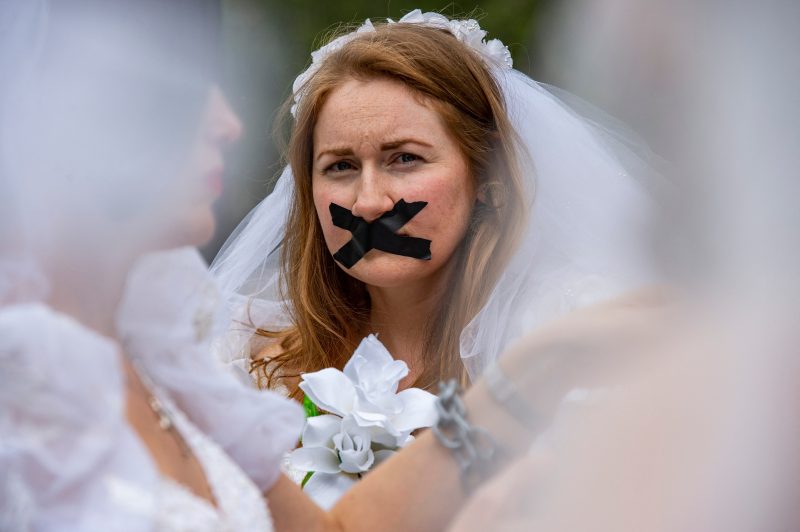When Sara Tasneem was 15 years old, her father told her she had to marry a 28-year-old stranger who was a member of his religious community in Palo Alto, Calif. The union began with a spiritual ceremony and, six months later when Tasneem became pregnant, it culminated with a quick Nevada wedding to legalize the marriage.
All state officials needed was a notarized permission slip from her father. It took Tasneem a decade to get out of the marriage.
Over the past five years, Tasneem and other American women who were married before they turned 18 have traveled across the nation, telling state lawmakers that these unions — which the United Nations and State Department define as “child marriages” — are more commonplace in the United States than many realize and overwhelmingly harmful to women.
“I was a freshman in high school,” Tasneem, now 42, said in an interview. “I was pregnant almost immediately and was pulled out of school. I didn’t learn to drive until I was 22.”
Although the United States joined with the U.N. in 2016 in a pledge to end child marriages by 2030, only seven states and two U.S. territories have made it illegal for people younger than 18 to get married. All other states allow it — sometimes with the permission of a parent, judge or both.
A group of advocates like Tasneem is aiming to change that, with at least 12 states this year considering child marriage bans that seek no exceptions to the 18-or-older rule.
“The most common exemption is parental consent, but the danger of that is when someone is forced to marry, the perpetrators are almost always the parent,” said Fraidy Reiss, founder of Unchained at Last, a nonprofit dedicated to ending child marriage that has led efforts on the new legislation.
The bills face an uphill battle in some states, though, where conservative lawmakers argue that younger teens have long been allowed to marry — often pointing to their own family’s stories as proof that it’s acceptable.
When a proposed child marriage ban in West Virginia was voted down last week in a Senate committee, state Sen. Mike Stuart (R) noted that his mother was married when she was 16, and “six months later I came along. I’m the luckiest guy in the world.”
With abortion now virtually outlawed across much of the nation, some lawmakers also argue that marriage should remain an option for pregnant teens. The bans could also run afoul of religious beliefs, they say.
“It’s not just emancipated children who will be unable to marry under this bill,” said Connecticut state Rep. Melissa Osborne (D), speaking against a marriage ban bill law last month. “It would be pregnant 17-year-olds who have strong religious beliefs that having a child out of wedlock would be worse than the predicament that they’re already in.”
In other states, lawmakers are simply unaware that marriages of people younger than 18 years old still exist in the United States, especially instances in which children are unwillingly coerced into the unions.
“I was shocked to learn that Delaware allowed children to marry,” said Delaware state Rep. Kimberly Williams (D), who sponsored the first successful state ban on the practice in 2018. “I started going to community meetings, talking about it, and people would ask, ‘Are you sure about this? The law allows for this?’”
Some opponents and civil liberty groups including the ACLU have also questioned whether there’s sufficient evidence behind the push for new laws, particularly in six states that do not track marriages by age.
“I don’t think there’s an overarching concern with the bills, but with some of our affiliates, they didn’t think there was data that shows the legislation is needed, ” said Sandra Park, senior attorney for the ACLU’s women’s rights project.
Studies and media reports, though, have estimated that hundreds of thousands of these marriages have taken place across the United States over the past two decades. A peer-reviewed study produced in 2021 by Unchained at Last, McGill University and other researchers estimated that nearly 300,000 Americans younger than 18 got married from 2000 to 2018, with 86 percent of them being girls. The marriages took place in every state and in the District of Columbia, the study found. Other studies show rates of divorce, dropping out of high school, domestic abuse and lifelong poverty are all dramatically higher for girls who marry before they are 18, advocates say.
The U.S. State Department has cited these same problems and calls marriages of people younger than 18 a “human rights abuse,” a case echoed in a recent Time magazine op-ed by Amal Clooney, Melinda French Gates and Michelle Obama, which said “marrying young has dire consequences” and called for an end to marriage before the age of 18.
The continued practice also clashes with U.S. foreign policy, which calls for an end to the practice.
“When my ambassador or even the secretary of state would call on other countries to ban child marriage, other countries would routinely say it’s legal in America and we would have nothing to say back,” said Jonathan Dach, chief of staff for Connecticut Gov. Ned Lamont (D) who worked for the State Department until 2017, testifying for a ban in his state last month. “America’s ability to stand up for girls everywhere depends on our standing up for girls here at home.”
Few states regulated the age for marriage until 1937, when Life magazine published a story called “The Case of the Child Bride” about a 22-year-old Tennessee tobacco farmer who married his 9-year-old neighbor. The Tennessee state legislature responded by setting a new minimum age of 16.
Several states followed suit, but each included provisions allowing minors to marry with a parent’s permission. In the 1960s and 1970s, another wave of state legislation sought to set new age limits on marriage, but none set a strict limit at 18 years old.
By 2015, 28 states still had no minimum age and all 50 states and the District of Columbia allowed marriage younger than 18. In the past eight years, though, advocates have had some success on the state level. Today seven states still have no minimum age, while seven other states have banned all marriages for people younger than 18.
There’s little formal study of who has continued to marry below that age, and advocates say circumstances vary widely. Some marriages are driven by traditional religious practices, while others result from teenagers getting pregnant. Sometimes parents broker marriages to engineer visas to the United States.
That’s what happened to Sasha K. Taylor, who was forced to marry a stranger — when she was a sophomore in an Arizona high school — so her husband could get a permanent visa in exchange for an unfulfilled promise that his family would pay for her college education.
“I was a visa bride at 15 for a college student who was 22,” said Taylor, who has since divorced and has described her story on a blog. “My mother and grandmother said, ‘He’s a college student. This will get you out of [my family’s] horrible house.’ I wasn’t given a choice. In almost every household where this happens there is child abuse and economic insecurity, and that was true for me.”
Taylor’s experience is reflected in a 2019 U.S. Senate Committee on Homeland Security and Governmental Affairs staff report — titled “How the U.S. Immigration System Encourages Child Marriages” — which said the government between 2007 and 2017 had approved nearly 8,700 visa petitions that listed spouses or fiances younger than 18.
The modern campaign to end such practices has been largely lead by two groups: the Tahirih Justice Center and Unchained at Last. Both were founded in part to help people leaving child marriages and forced marriages to start new lives. But the groups found that when girls younger than 18 reached out for help, their hands were tied by the law.
“All the cases are complex, but there are legal limitations to the rights that children have,” said Alex Goyette, Tahirih’s senior public policy adviser. “They can’t do simple things like sign a lease for an apartment, or even drive or find work in some cases because they are too young.”
Girls younger than 18 also can’t seek help from domestic violence shelters and, in most states, are unable to enter into contracts with divorce lawyers, Reiss said.
“Even if you are brave enough to reach out to advocates like us, there’s almost nothing we can do for you until the day you turn 18,” Reiss said. “We’re not arguing that you wake up on your 18th birthday with a newfound wisdom and maturity and this sudden ability to choose a life partner, but you do wake up with the rights of adulthood.”
That led the groups to focus on changing state laws. Tahirih’s group has worked to tighten laws to limit marriages younger than 18; its first victory came in 2016 when the Virginia state legislature passed a bill that only allows minors to marry if they are first emancipated by a court, which gives them legal authority to make decisions without the permission from a parent or guardian.
“I think from the beginning, our principles have been to start with a bright line of 18 and push as hard as we can,” Casey Carter Swegman, who oversees Tahirih’s Forced Marriage Initiative, said in a statement. “When that becomes obviously unachievable, we will not walk away from a strong compromise that we know will protect at least some children.”
Since the Virginia bill passed, 25 states have moved the needle on child marriage laws — but haven’t completely banned it. In most cases, a minimum age was set at 16 or 17, requiring parental consent and sometimes a case review by a judge. In others, the age difference between the spouses was limited to four, three or two years.
In West Virginia, for example, after a proposed ban on marriages of people younger than age 18 failed last week, the legislature on Saturday passed a bill that requires parental consent for 16- and 17-year-olds to marry — and also allows them to annul the marriage for any reason without parental consent.
“This is a good first step, but we will keep fighting to set it at age 18,” said West Virginia Del. Kayla Young (D), the lead sponsor on the bill.
Unchained at Last, meanwhile, will withdraw its support for a bill unless it calls for a firm ban on marriages of people younger than 18 with no exceptions. The group’s first success came in 2018 in Delaware.
That same year, the group helped form the National Coalition to End Child Marriage in the United States, a network of groups that coordinates testimony against any legislation that grants exceptions from witnesses like Tasneem who were coerced into marriage before they turned 18. They argue exceptions undermine statutory rape laws, since adult men can escape criminal charges if they marry underage victims.
Some state and national organizations have also expressed concern about complete bans of marriages for people younger than 18. In addition to ACLU’s questions about data, the Children’s Law Center of California has also argued marriage has benefited some of its clients by allowing underage parents to be legally recognized as a family, and helping minors establish legal independence to exit the foster care system.
However, advocates and bill sponsors say there’s little organized opposition to limits on marriage before age 18. The biggest challenge are crowded legislative agendas and state legislatures that often meet for only a few months each year.
“Our biggest obstacle is not that there’s someone standing outside with a picket sign saying, ‘I want child marriage,’ Legislators are looking at this and just kind of yawning,” Reiss said. “Legislators are not accustomed to making girls a legislative priority. They are not old enough to vote. They are easy to look past.”
This story previously misstated the location of the religious community that Sara Tasneem’s father belonged to. The community was in Palo Alto, Calif.








